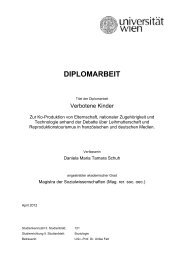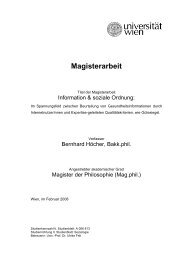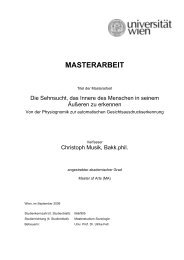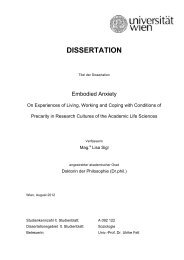MASTERARBEIT - Institut für Wissenschaftsforschung - Universität ...
MASTERARBEIT - Institut für Wissenschaftsforschung - Universität ...
MASTERARBEIT - Institut für Wissenschaftsforschung - Universität ...
You also want an ePaper? Increase the reach of your titles
YUMPU automatically turns print PDFs into web optimized ePapers that Google loves.
introduction 5<br />
The zeppelin became an iconic and celebrated technology that is<br />
remembered and capable of attracting attention until today. This fact<br />
alone makes it wothwhile studying. As already observed by Hecht<br />
[20, 254], »technologies serve[d] as important symbols for national<br />
identity [. . . ]. The relationship between technological change and national<br />
identity went both ways.« Particularly the early setbacks for<br />
the technology and the turn to its success and the incorporation of a<br />
national symbol are very interesting. In my thesis, I want to take a<br />
look at how the perception of the zeppelin and its technological development<br />
proceeded. Most importantly, however, I want to observe<br />
in which way the forming of a shared perception of the technologies<br />
fed back to its development - and also influenced the society in which<br />
it took place. Studying the relation of science, technology and society,<br />
it is of course a focus of my interest whether the perception in society<br />
and the development of the technology were related to each other.<br />
As I found, especially the early days of this technology were a very<br />
interesting history of ups and downs. Particularly the events around<br />
the crash of LZ-4 in 1908 and the national donation following it do indicate<br />
there has been a relation between the two. And while there are<br />
plenty of narratives of what happened and who did what, I found<br />
a conclusive reflection on the basis of theoretical considerations as<br />
social sciences try to give to be missing.<br />
I hope to be able to contribute to this field of literature in a way<br />
that works on this niche that seems still to be empty. Trying to do<br />
so, I will run the risk of just running down the beaten path: narratives<br />
about the development of Zeppelin airships are manifold and a<br />
standard narrative has evolved. However, I do not want to re-tell this<br />
story just once more. Instead, I want to apply theoretical concepts<br />
the Science, Technology, Society (STS) community has developed in<br />
order to gain new insights on the emergence and stabilization of a<br />
technology. Particularly, I want to use a Social Construction of Technology<br />
(SCOT) [2, 3, 40] approach to show how different publics have<br />
been involved into the process of developing this technology and how<br />
this involvement has affected the development of the zeppelin. Albeit<br />
SCOT has been around for more than twenty, almost thirty years, its<br />
basic assumptions are still the same. While there have been some efforts<br />
to broaden its perspective, some aspects are still not a focus of<br />
the theoretical approach. In my opinion, however, SCOT might very<br />
well benefit from connections to other schools of thoughts. In this<br />
work I try to combine it with some recent work by Sheila Jasanoff,<br />
her concept of Sociotechnical Imaginaries (STI) [27, 14]. Thereby I<br />
want to integrate time, a dimension not regarded much by SCOT, into<br />
the set of considerations that play a role in technology development.<br />
Moreover, Jasanoff provides strong arguments on how ’technical’ and<br />
’social’ influence each other. She offers explanations on how social<br />
and technological developments not only influence each other in a







